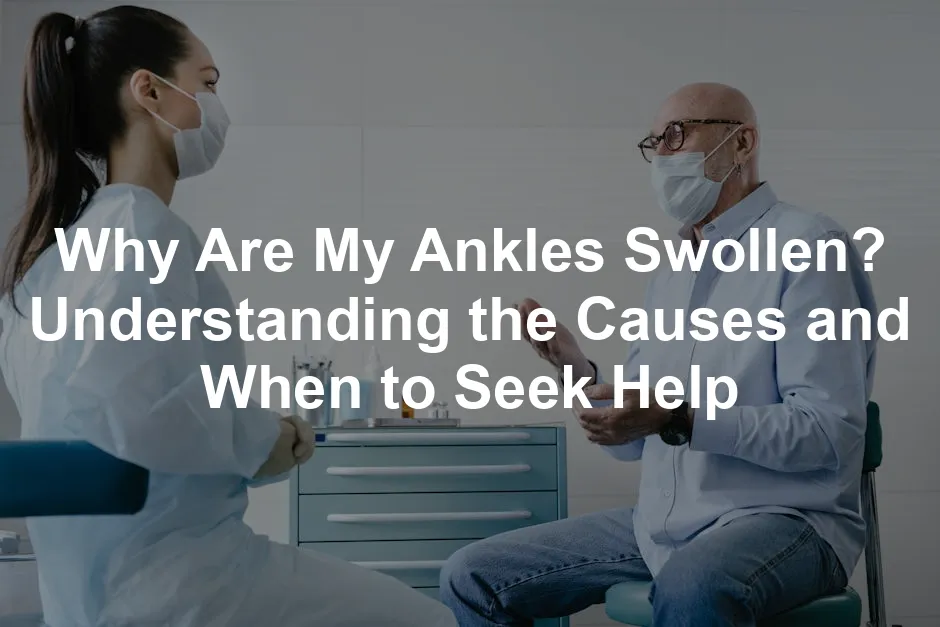
Why Are My Ankles Swollen? Understanding the Causes and When to Seek Help
Introduction
Ankle swelling is a common issue many people face. It can happen for various reasons, and while occasional swelling is usually harmless, persistent or severe cases can indicate a more serious condition. Understanding the causes behind your swollen ankles is essential for effective treatment and management. In this post, we’ll explore the possible reasons for your swollen ankles, discuss treatment options, and guide you on when to seek medical help. Speaking of treatment options, have you ever tried wearing compression stockings? They can be a game changer for improving blood flow and reducing that pesky swelling!Summary and Overview
Ankle swelling, medically known as edema, occurs when excess fluid accumulates in the tissues of your lower legs. This condition can arise from numerous factors, including lifestyle choices, underlying medical conditions, and even certain medications. Throughout this article, we’ll discuss the most common causes of ankle swelling, associated symptoms, treatment options, and when it’s crucial to consult a healthcare professional. Recognizing the reasons behind your swelling is vital for proper management and care. If you’ve ever dealt with injuries, you know how frustrating they can be. An ice pack for injuries is a must-have in every first-aid kit! It helps reduce swelling and numbs pain, making your recovery process so much smoother.Common Causes of Ankle Swelling
Edema vs. Inflammation
Edema refers to the accumulation of fluid in specific tissues, leading to swelling. It’s often noticeable in the legs, ankles, and feet. This fluid retention can occur due to various factors, such as prolonged sitting or standing, high salt intake, or certain medical conditions. For example, kidney issues or heart failure can cause significant edema. On the other hand, inflammation is the body’s immune response to injury or infection. It can manifest as swelling and pain in the affected area. Conditions like arthritis or a sprained ankle often lead to inflammation. While both edema and inflammation result in swelling, they stem from different processes. Understanding these differences can help you identify the root cause of your swollen ankles. Reflect on your symptoms. Are they related to your lifestyle or a possible medical condition? Exploring these factors can help you determine the next steps in managing your ankle swelling. And if you’re looking for a comprehensive guide, consider picking up The Complete Guide to Ankle Injuries. It’s like having a personal trainer for your ankles!1. Lifestyle Factors
Prolonged Sitting or Standing
Inactivity can lead to fluid buildup in your lower body. When you sit or stand for long periods, gravity causes blood to pool in your legs, resulting in swelling. To mitigate this, incorporate movement breaks during your day. Simple exercises like ankle pumps or leg stretches can improve circulation and reduce swelling. Consider standing up, walking around, or even elevating your legs when possible. These small changes can make a significant difference in managing your ankle swelling and enhancing overall comfort. So, don’t forget to move! And if you’re working at a desk, an adjustable footrest can help keep your feet elevated and comfy!
2. Medical Conditions
Chronic Venous Insufficiency
Chronic Venous Insufficiency (CVI) occurs when leg veins struggle to send blood back to the heart. This condition causes blood to pool in the legs, leading to swelling. Symptoms of CVI can include aching, heaviness, and visible varicose veins. Over time, CVI may also result in skin changes or ulcers. Treating CVI typically involves lifestyle changes, such as exercising and elevating the legs. Compression stockings can also help improve blood flow. Risk factors include age, obesity, and a family history of the condition. If you suspect CVI, please consult with a doctor for proper evaluation and management.Heart, Liver, or Kidney Disease
Heart, liver, and kidney diseases can cause significant fluid buildup in the body, leading to swollen ankles. In heart failure, the heart fails to pump blood effectively, causing blood to back up in the veins. Symptoms may include fatigue, shortness of breath, and swelling, usually worsening in the evening. Liver disease often lowers protein levels in the blood, causing fluid leakage into surrounding tissues. Symptoms might include jaundice, fatigue, and abdominal swelling. Kidney issues can prevent the body from filtering waste and excess fluid, resulting in swelling. Symptoms can include changes in urination and fatigue. Early diagnosis is crucial for these conditions. They disrupt the delicate balance of fluids in your body, leading to discomfort and complications. If you experience related symptoms, seek medical advice promptly. And speaking of balance, a balance board can be a fun way to improve your stability while working on your ankle strength!
3. Pregnancy-Related Swelling
Preeclampsia
Preeclampsia is a serious pregnancy complication characterized by high blood pressure and excess protein in urine. Sudden swelling in the face, hands, or feet during pregnancy may indicate this condition. Other symptoms include severe headaches, vision changes, and abdominal pain. Monitoring swelling during pregnancy is essential. While some swelling is normal, sudden changes can signal a need for medical attention. Risk factors for preeclampsia include obesity, a history of high blood pressure, and multiple pregnancies. Pregnant women should report any sudden swelling to their healthcare provider immediately for evaluation and care.
4. Injuries and Infections
Sprains and Other Injuries
Injuries to the ankle, such as sprains, can lead to localized swelling and inflammation. A sprained ankle occurs when ligaments are stretched or torn, often due to a misstep or fall. The result? Pain, bruising, and, of course, swelling. To treat an ankle injury, follow the R.I.C.E. method: Rest, Ice, Compression, and Elevation. Rest allows healing, while ice reduces swelling and numbs pain. Compression with a bandage helps support the ankle, and elevation diminishes fluid buildup. Speaking of which, a R.I.C.E. method first aid kit can help you be prepared for any sprain or strain! It’s essential to monitor your injury. If swelling or pain worsens or doesn’t improve after a few days, seek medical attention. Proper care can speed up recovery and minimize complications, ensuring you’re back on your feet in no time.
5. Medication Side Effects
Common Medications That Cause Swelling
Certain medications can lead to ankle swelling as a side effect. These include antidepressants, steroids, and some blood pressure medications. They may cause fluid retention, leading to noticeable swelling in the ankles and feet. If you notice swelling after starting a new medication, consult your doctor. They can help determine if your medication is the culprit and discuss potential alternatives or adjustments. Ignoring these side effects can lead to discomfort or exacerbate underlying conditions. Always keep your healthcare provider informed about any changes in your symptoms. Reviewing your medications regularly can help prevent unwanted side effects and promote your overall well-being. And don’t forget to pamper yourself with a foot massager to relieve some of that tension!
Conclusion
Swollen ankles can result from various factors, including lifestyle choices and medical conditions. Monitoring your symptoms is essential for effective management. If you notice persistent or severe swelling, don’t hesitate to seek medical evaluation. Early intervention can prevent complications and improve your overall health. Maintaining a healthy lifestyle can also make a significant difference. Focus on regular exercise, a balanced diet, and staying hydrated. Being proactive about your health empowers you to manage swelling and enhance your well-being. Remember, your body communicates with you; listen to it! And if you want to stay hydrated, consider investing in a hydration water bottle to keep your fluids in check!
Regular exercise is essential for maintaining mobility, especially for seniors. why should senior citizens perform balance exercises
Frequently Asked Questions
When should I worry about swollen ankles?
You should seek help if your swollen ankles show signs of serious issues. Look for heat, discoloration, or sudden swelling. A fever accompanying swelling could also indicate an infection. If you have a history of heart, kidney, or liver disease, consult your doctor immediately. Persistent or worsening swelling should never be ignored.
What are some home remedies for swollen ankles?
Managing minor swelling at home can be effective. Consider elevating your legs above heart level. This helps reduce fluid retention. Applying ice packs can also relieve discomfort. Compression stockings may improve circulation. Lastly, reducing salt intake can prevent further swelling. These home remedies can provide relief for swollen ankles.
Can diet affect ankle swelling?
Yes, your diet plays a significant role in fluid retention. High salt intake can lead to increased water retention, making your ankles swell. Focus on eating a balanced diet rich in fruits, vegetables, and whole grains. Staying hydrated helps your body manage fluids better. Make mindful dietary choices to support overall health and reduce swelling.
Is ankle swelling a sign of a serious condition?
Ankle swelling can sometimes point to serious conditions. It’s essential to recognize these signs early. For example, heart disease can lead to fluid buildup in your lower extremities. When the heart can’t pump effectively, blood backs up in the veins, causing swelling. Liver disease is another culprit. It often results in decreased protein levels, leading to fluid leakage into surrounding tissues. Symptoms may include jaundice or abdominal swelling alongside your ankle issues. Kidney problems can also cause swelling. When kidneys fail to filter waste properly, fluid accumulates, especially in the legs and ankles. If you notice other symptoms, like changes in urination or fatigue, it’s time to consult your doctor. Other serious conditions include deep vein thrombosis (DVT) and infections. DVT occurs when a blood clot forms in a vein, leading to swelling and pain. Infections can cause localized swelling and warmth, signaling a need for immediate medical attention. Monitoring your ankle swelling and associated symptoms is crucial. If you have ongoing swelling or notice other concerning symptoms, seek medical advice promptly. Understanding the potential serious conditions linked to ankle swelling can help you take proactive steps for your health.
Can exercise help reduce swollen ankles?
Absolutely! Engaging in regular exercise can significantly help reduce swelling in your ankles. Physical activity promotes better circulation, allowing blood to flow more freely throughout your body. This increased circulation can help prevent fluid buildup in your lower legs. Simple activities, like walking or cycling, are great options. They encourage movement without putting too much strain on your body. Even gentle stretching can improve blood flow and reduce swelling. If you’re at a desk for long periods, take breaks to stand, stretch, and move around. Incorporating ankle exercises can also be beneficial. Try ankle pumps, where you point and flex your feet. This action helps stimulate circulation and can alleviate swelling. Remember to listen to your body. If swelling persists despite regular exercise, consider consulting a healthcare professional. Exercise is a powerful tool in managing swollen ankles and enhancing your overall well-being.
All images from Pexels




